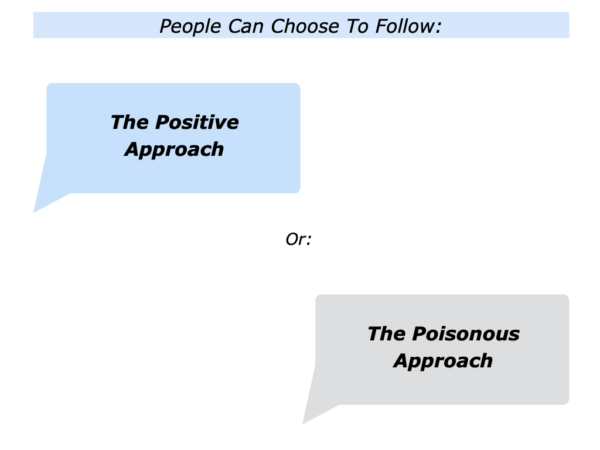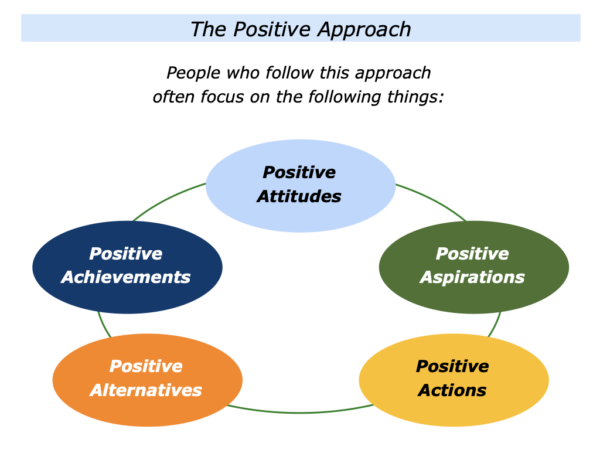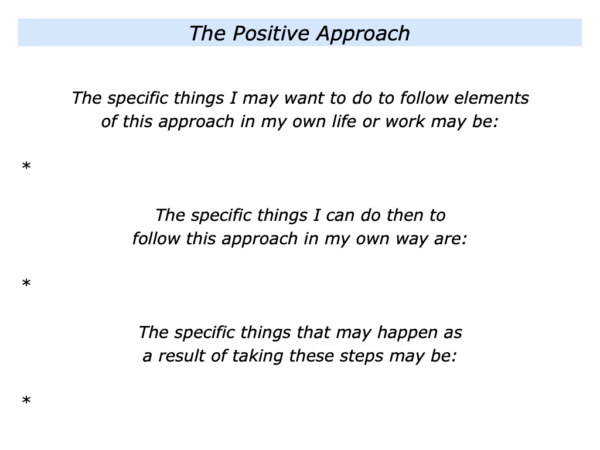
Different people choose to follow different routes in life. The approach they follow can have positive or negative consequences for both themselves and other people.
Some people choose to follow the positive approach. They focus on positive attitudes, aspirations and actions. They also focus on positive alternatives – such as solutions to challenges – and achievements.
Some people follow the poisonous approach. They may be addicted to anger or hurting others. They may also act in ways that spread poison. This can create collateral damage and pain for other people.
Different people follow these routes for different reasons. Some choose to follow a certain route because they recognise the old saying that:
What We Focus On We Become
If we focus on positive things – and the possible solutions to challenges – we are more likely to feel positive. We are then more likely to behave in positive ways towards other people.
If we focus on poisonous things – without finding possible solutions – we are more likely to put poison into our system. We are then more likely to spread this feeling towards other people.
The Positive Approach
Some people choose to follow the positive approach. They focus on the following themes.

Positive Attitudes
People who take this approach start with themselves. They choose to be positive rather than negative, be creators rather than complainers, take responsibility rather than avoid responsibility.
They build on what they can control. They also good at reading reality and recognising patterns. They then aim to build on the successful patterns and manage the consequences of any unsuccessful patterns.
Such people study others who have positive attitudes. They learn from people who have built on their strengths, managed adversity and done their best to tackle challenges.
They have a sense of gratitude and enjoy being generous. They focus on what some people call the love part of the brain rather than the lizard part of the brain. They want to help other people during their time on the planet. This links to the next theme.
Positive Aspirations
People who take this approach often focus on positive aspirations. They may aim to build on their strengths, follow strategies that work and achieve their picture of success.
Such people may also help other people to focus on their aspirations. When appropriate, they may encourage them to work towards their personal or professional goals.
Some people take this approach in their work as educators, coaches, trusted advisors, leaders or in other roles. They then aim to provide practical tools that people can use to achieve their goals.
Positive Actions
People who take this approach may aim follow their chosen philosophy, a spiritual faith or a moral compass. They then aim to translate these principles into action in their daily lives and work.
Such people recognise that they make choices every minute. The choices they make have consequences – both for themselves and other people. They therefore aim to act in ways that help rather than hurt other people.
They may also study the characteristics that are admired across many civilisations. These include generosity, kindness and wisdom. They may try to follow these in their own way during their time on the planet.
Positive Alternatives
People who take this approach are prepared to tackle challenges. When doing so, they often study the positive alternatives and strategies that are most likely to work in such situations. Bearing in mind what they can control, they then aim:
To clarify the real results to achieve – the picture of success;
To clarify the possible options and the consequences – the pluses and minuses of each option – together with any potential creative solutions;
To clarify the route the want to follow, translate it into action and do their best to achieve the picture of success.
Such people keep adding to their repertoires for tackling challenges. Some may also pass on these ideas to other people to help them to achieve success. This leads to the next step.
Positive Achievements
People who take this approach often go through the stages of awareness, application and achievement. They love to keep developing, expand their awareness and translate this into setting specific goals.
They then apply themselves fully, perform superb work and find solutions to challenges. They aim to keep improving and do their best to achieve their picture of success.
Different people do, of course, have different definitions of success. They may aim to encourage other people, be healthy, build a happy family, deliver a creative project or give positive things to people during their time on the planet.
Some people may also enjoy helping others to achieve their goals. They may therefore aim to find ways to pass on knowledge and practical tools that other people can use to achieve success.
There are many ways to live life. Some people choose to follow the positive approach, some follow the poisonous approach. The route they follow can help or hurt people.
Let’s return to your own life. Looking ahead, imagine that you want to follow some elements of the positive approach. How can you do this in your own way? What may happen as a result of taking these steps?
If you wish, try tackling the exercise on this theme. This invites you to complete the following sentences.



Leave a Reply